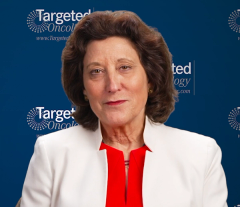
HR+/HER2 Metastatic Breast Cancer: Future Directions in Care
Closing out her discussion on the treatment and management of HR+/HER2- mBC, Hope Rugo, MD, FASCO, highlights unmet needs and future directions in the field.
Episodes in this series

Case: A 57-Year-Old Woman with HR+/HER2- Metastatic Breast Cancer
Presentation
- A 57-year-old postmenopausal woman with a personal history of breast cancer presented with sternal pain during a followup appointment
Patient history
- She was diagnosed with stage I ER+/HER2- disease 8 years ago, at 49 years of age
- At the time, she was prescribed 5 years of adjuvant letrozole treatment, which she completed 3 years ago
Physical exam, clinical workup, and imaging
- Mid-sternum tenderness to palpation
- Slight elevation in ALP, all other lab testing unremarkable
- Bone scan showed uptake in sternum, scapula, lumbar spine, iliac crest
- Chest/abdomen/pelvis CT revealed sclerotic bone lesions
- Iliac bone biopsy confirmed ER+/HER2- metastatic breast cancer
- NGS on biopsy sample was negative for mutations
- ECOG PS=1
Treatment/followup
- The patient received letrozole and ribociclib as first-line treatment for metastatic disease
- 24 months after treatment initiation, CT showed enlargement of bone lesions and a single new 2-cm liver lesion
- Liquid biopsy/ctDNA testing revealed an ESR1 mutation
- The patient then started on elacestrant 345 mg once daily
Transcript:
Hope Rugo, MD, FASCO: Where do we go from here? We have our first oral SERD [selective estrogen receptor degrader], which is very exciting. It seems to have taken forever to get here. It’s great to have an oral SERD that’s approved and a specific patient population, with tumor mutations, that benefits from this. We also have some information about the criteria for patients who have more endocrine-sensitive diseases, using the surrogate marker of how long their disease was controlled on CDK4/6 inhibitors. This gives us an idea of which patients might benefit for a long time from elacestrant as a single agent. That’s a big step forward.
We already know about CDK4/6 inhibitors, but we need to understand if they work after progression. The postMONARCH trial, which is ongoing, will give us important data on that. We have a new targeted agent, the AKT inhibitor capivasertib. We’ll see ongoing data from that trial, waiting for survival data and events. It seems to be a drug that’s better tolerated than alpelisib, without as much hyperglycemia and with controllable rash and diarrhea. That will be a very important drug when it’s approved, we hope in 2023.
We have a whole host of oral SERDs and agents that work on the estrogen receptor. As I mentioned, ubiquitination with the PROTAC ARV-471. There are SERCAs—drugs that work by a different mechanism of ER [estrogen receptor] degradation—and oral SERDs. There are trials comparing single-agent oral SERDs to fulvestrant. Initial studies are looking at combinations, even triplets, with CDK4/6 inhibitors, and aromatase inhibitors in the early stage setting with some of our targeted agents. Someday they will also be combined with oral SERDs. Capivasertib will be combined with camizestrant, which is the same company as oral SERDs, and explored in combination with elacestrant once it’s approved. That’s important as well.
There are a lot of trial data that we’re going to see in the near future—maybe a 1-, 2-, 3-year time frame. We’re going to need to think about how we’re sequencing and using these agents. Of course, we have more targeted agents that are novel and more specific. PI3 kinase inhibitors cross the blood-brain barrier and work on a specific mutation, PIK3CA. There are oral SERDs that may work on specific ESR1 mutations or may work better on specific mutations vs others. We need to investigate that as we get more agents approved and have positive phase 3 data.
We’re still looking to see which patients with hormone receptor–positive disease benefit from immunotherapy. We’re trying to understand sequencing of antibody-drug conjugates and if using them earlier as first-line chemotherapy agents will be better. There are lots of studies going on, with lots of exciting data to look for in the future. We’re already making tremendous strides.
Transcript edited for clarity.









































